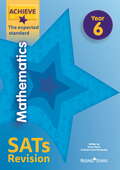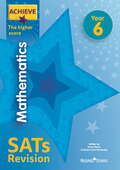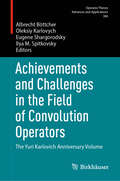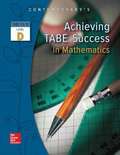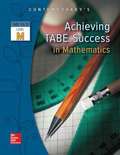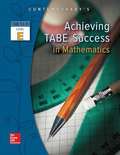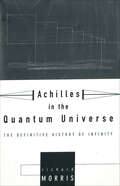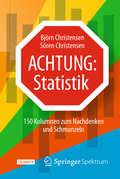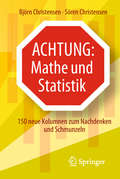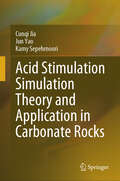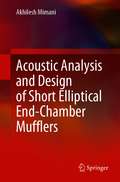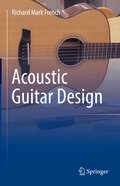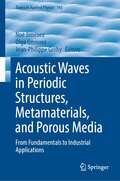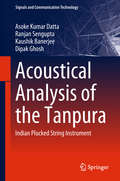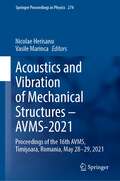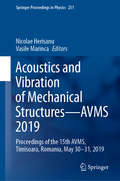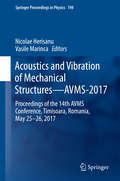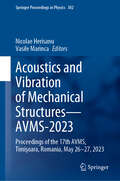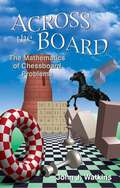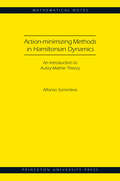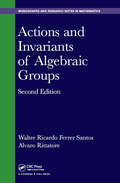- Table View
- List View
Achieve Mathematics SATs Revision The Expected Standard Year 6 (Achieve Key Stage 2 SATs Revision)
by Trevor Dixon Solvemaths LtdAchieve. Fun and focused SATs revision.Achieve the Expected Standard in mathematics, with the only fully updated revision series. This book teaches children exactly how to tackle SATs questions (even the tricky ones) with confidence to get their best result. This book covers everything that could be tested while ensuring children have some fun while they learn.Our unique approach has been helping children and schools perform above national average for over 15 years. Children are guided step-by-step through all question types and easy-to-digest content is presented in a simple to follow format. Clear explanations and lots of practice make it the perfect revision range for use in school and at home. This revision book:- Teaches children how to tackle SATs questions ...and get them right!- Focuses revision for the greatest impact on final marks- Draws on expert analysis to ensure our content is just right - Provides full guidance by topic, and includes important facts, keywords, SATs terminology, tips and example practice questions - Offers digestible content and lots of opportunities to practise, making it perfect for use in school or at home For best results use alongside Achieve Mathematics SATs Question Workbook The Expected Standard Year 6 and Achieve Mathematics SATs Practice Papers
Achieve Mathematics SATs Revision The Higher Score Year 6 (Achieve Key Stage 2 SATs Revision)
by Trevor Dixon Solvemaths LtdAchieve. Fun and focused SATs revision.Achieve the Higher Score in mathematics, with the only fully updated revision series. This book teaches children exactly how to tackle the more demanding SATs questions with confidence to get their best result. For use with more able children, this book covers everything that could be tested and provides additional challenge while ensuring children have some fun while they learn.Our unique approach has been helping children and schools perform above national average for over 15 years. Children are guided step-by-step through all question types and easy-to-digest content is presented in a simple to follow format. Clear explanations and lots of practice make it the perfect revision range for use in school and at home. This revision book:- Focuses revision on the key information children need to reach the higher score- Shows children how to get full marks on extended questions- Teaches children how to answer test questions thoughtfully and appropriately- Offers digestible content and lots of opportunities to practise,making it perfect for use in school or at homeFor best results use alongside Achieve Mathematics SATs Question Workbook The Higher Score and Achieve Mathematics SATs Practice Papers
Achievements and Challenges in the Field of Convolution Operators: The Yuri Karlovich Anniversary Volume (Operator Theory: Advances and Applications #306)
by Eugene Shargorodsky Albrecht Böttcher Ilya M. Spitkovsky Oleksiy KarlovychThis volume, which is dedicated to Yuri Karlovich on the occasion of his 75th birthday, includes biographical material, personal reminiscences, and carefully selected papers. The contributions constituting the core of this volume are written by mathematicians who have collaborated with Yuri or have been influenced by his vast mathematical work. They are devoted to topics of Yuri Karlovich's work for five decades, starting with his work on singular integral operators with shift, then broadened to include Toeplitz, Wiener-Hopf, Fourier and Mellin convolution and pseudodifferential operators, factorisation of almost periodic matrix functions, and local trajectory methods for the study of algebras of convolution and singular integral operators.
Achieving Fluency: Special Education And Mathematics
by Francis M. Fennell National Council of Teachers of Mathematics StaffPresents the understandings that all teachers need to play a role in the education of students who struggle: those with disabilities and those who simply lack essential foundational knowledge. This book serves teachers and supervisors by sharing increasingly intensive instructional interventions for struggling students on essential topics aligned with NCTM's Curriculum Focal Points, the new Common Core State Standards for Mathematics, and the practices and processes that overlap the content. These approaches are useful for both overcoming ineffective approaches and implementing preventive approaches.
Achieving TABE Success In Mathematics Level D
by McGraw-Hill Education Staff ContemporaryThe Achieving TABE Success family is designed to provide complete skill preparation and practice for TABE 9&10, encompassing Reading, Mathematics and Language, for levels E, M, D and A. This series of books will help students achieve NRA gain through targeted instruction that specifically addresses TABE 9&10 skills. Achieving TABE Success . . . workbooks contain the following features: TABE 9&10 Correlation Charts Each text contains a TABE 9&10 Correlation Chart that links each question to targeted skill lessons, enabling instructors and students to build a personalized study plan based on skill level strengths and weaknesses. Pre-tests and Post-tests Each workbook begins with a pre-test and a skills correlation chart to help diagnose strengths and weaknesses and determine TABE readiness. The format of each pre- and post-test matches that of the actual TABE test. Targeted TABE Skill Lessons Each lesson specifically targets a TABE skill. Students work with the innovative lesson format that provides step-by-step instruction to help insure success. The Mathematics lessons offer plenty of instruction and practice to help master each TABE skill. Unit Reviews and Math Glossary Unit reviews are divided into two parts: Review, which summarizes unit content, and Assessment, to determine student understanding. Mathematics texts contain a Glossary of Common Terms to help students with the language of math. Text/TABE Level Content Level Level E 2. 0 - 3. 9 Level M 4. 0 - 5. 9 Level D 6. 0 - 8. 9 Level A 9. 0 - 12. 9
Achieving TABE Success In Mathematics, TABE 9 And 10 Level M
by Contemporary Mcgraw-Hill Education Firm StaffThe Achieving TABE Success family is designed to provide complete skill preparation and practice for TABE 9&10, encompassing Reading, Mathematics and Language, for levels E, M, D and A. This series of books will help students achieve NRA gain through targeted instruction that specifically addresses TABE 9&10 skills. Achieving TABE Success . . . workbooks contain the following features: TABE 9&10 Correlation Charts Each text contains a TABE 9&10 Correlation Chart that links each question to targeted skill lessons, enabling instructors and students to build a personalized study plan based on skill level strengths and weaknesses. Pre-tests and Post-tests Each workbook begins with a pre-test and a skills correlation chart to help diagnose strengths and weaknesses and determine TABE readiness. The format of each pre- and post-test matches that of the actual TABE test. Targeted TABE Skill Lessons Each lesson specifically targets a TABE skill. Students work with the innovative lesson format that provides step-by-step instruction to help insure success. The Mathematics lessons offer plenty of instruction and practice to help master each TABE skill. In the Reading and Language workbooks, the lessons are divided into four parts for a graduated approach to learning: Introduce clearly defines, explains, and illustrates the skill, and includes examples. Practice presents work related to the skill just introduced. Apply reinforces the skill through activities and exercises. Check Up evaluates student comprehension. Unit Reviews and Math Glossary Unit reviews are divided into two parts: Review, which summarizes unit content, and Assessment, to determine student understanding. Mathematics texts contain a Glossary of Common Terms to help students with the language of math. Text/TABE Level Content Level Level E 2. 0 - 3. 9 Level M 4. 0 - 5. 9 Level D 6. 0 - 8. 9 Level A 9. 0 - 12. 9
Achieving Tabe Success In Mathematics Level E
by McGraw-Hill Education Staff ContemporaryThe Achieving TABE Success family is designed to provide complete skill preparation and practice for TABE 9&10, encompassing Reading, Mathematics and Language, for levels E, M, D and A. This series of books will help students achieve NRA gain through targeted instruction that specifically addresses TABE 9&10 skills. Achieving TABE Success . . . workbooks contain the following features: TABE 9&10 Correlation Charts Each text contains a TABE 9&10 Correlation Chart that links each question to targeted skill lessons, enabling instructors and students to build a personalized study plan based on skill level strengths and weaknesses. Pre-tests and Post-tests Each workbook begins with a pre-test and a skills correlation chart to help diagnose strengths and weaknesses and determine TABE readiness. The format of each pre- and post-test matches that of the actual TABE test. Targeted TABE Skill Lessons Each lesson specifically targets a TABE skill. Students work with the innovative lesson format that provides step-by-step instruction to help insure success. The Mathematics lessons offer plenty of instruction and practice to help master each TABE skill. In the Reading and Language workbooks, the lessons are divided into four parts for a graduated approach to learning: Introduce clearly defines, explains, and illustrates the skill, and includes examples. Practice presents work related to the skill just introduced. Apply reinforces the skill through activities and exercises. Check Up evaluates student comprehension. Unit Reviews and Math Glossary Unit reviews are divided into two parts: Review, which summarizes unit content, and Assessment, to determine student understanding. Mathematics texts contain a Glossary of Common Terms to help students with the language of math. Text/TABE Level Content Level Level E 2. 0 - 3. 9 Level M 4. 0 - 5. 9 Level D 6. 0 - 8. 9 Level A 9. 0 - 12. 9
Achilles in the Quantum Universe: The Definitive History of Infinity
by Richard MorrisCenturies ago, when the ancient philosopher Zeno proposedhis famous paradox involving Achilles and the Tortoise, he struck at the heart of one of science's most enduring and intractable problems: How do we define the infinite? From then on, our greatest natural philosophers, logicians, mathematicians, and scientists, from Aristotle to Stephen Hawking, have been stymied-and driven-by infinity.Acclaimed Science writer Richard Morris guides us on a fascinating, literate and entertaining tour of the efforts made throughout history to make sense of the mind-bending concept of the infinite. In tracing this quest, Morris shows us how each new encounter with infinity drove the advancement of physics and mathematics. Along the way, we encounter such luminaries as Galileo and Newton, Tycho Brahe and Giordano Bruno, and the giants of modern physics: Planck, Einstein, Bohr, Feynmann, Hawking, and numerous others.Beginning with simple logical puzzles and progressing to the latest cosmological theories, Morris shows how these same infinity problems helped spawn such groundbreaking scientific developments as relativity and quantum mechanics. Though in many ways, the infinite is just as baffling today as it was in antiquity, contemporary scientists are probing ever deeper into the nature of our universe and catching fleeting glimpses of the infinite in ways the ancients could never have imagined.Ultimately, we see that hidden within the theoretical possibility of an infinite number of universes may lie the answers to some of humankind's most fundamental questions: Why is there something rather than nothing? Why are we here?
Achtung: 150 Kolumnen zum Nachdenken und Schmunzeln
by Björn Christensen Sören ChristensenMit 150 Kolumnen ,,Achtung Statistik" bietet das Buch eine kurzweilige Möglichkeit, Statistik zukünftig mit anderen Augen zu sehen, kritisch zu hinterfragen und in Einzelfällen sogar wissenschaftliche Top-Nachrichten mit gesundem Menschenverstand als statistische ,,Rohrkrepierer" zu entlarven. Geprägt durch den Spruch: ,,Trau keiner Statistik, die du nicht selbst gefälscht hast!" hat die Statistik wirklich keinen guten Ruf. Sie gilt als eine trockene, schwierige Materie, die uns zwar auf Schritt und Tritt in Schule, Studium und Beruf, aber auch in den Medien begegnet, zu der die meisten aber kaum Zugang finden. Die Autoren zeigen, dass es möglich ist, ohne besondere Vorbildung und mit einem Schmunzeln interessante und erstaunliche statistische Erkenntnisse zu gewinnen, zu deren Verständnis keine Formeln nötig sind. Die seit 2012 regelmäßig im ,,Schleswig-Holstein Journal" publizierten Kolumnen wurden für das Buch um weitergehende Erläuterungen und Beispiele ergänzt.
Achtung: 150 neue Kolumnen zum Nachdenken und Schmunzeln
by Björn Christensen Sören ChristensenStatistik und Mathematik prägen unser Leben so stark wie noch nie. Trotzdem gilt die Welt der Zahlen und Strukturen oft als abstrakt und kompliziert. Dieses Buch tritt den Gegenbeweis an: Die Autoren zeigen auf unterhaltsame Art, wie man – ganz ohne Formeln und besondere Vorbildung – erstaunliche statistische und mathematische Erkenntnisse gewinnen kann. Grundlage dafür bilden 150 auf SPIEGEL ONLINE und im „Schleswig-Holstein Journal“ publizierte Kolumnen, die für das Buch teilweise kommentiert und ergänzt wurden. Die Zusammenstellung lädt dazu ein, zwischen den einzelnen Kapiteln und Abschnitten hin- und her zu springen, darin zu schmökern und fast beiläufig den eigenen „gesunden Menschenverstand“ zu schulen. Das Buch führt somit das erfolgreiche Konzept des bereits veröffentlichten Werks „Achtung: Statistik“ mit neuen Inhalten und erweitertem inhaltlichem Fokus fort.
Acid Stimulation Simulation Theory and Application in Carbonate Rocks
by Jun Yao Cunqi Jia Kamy SepehrnooriThis book provides a theoretical basis and technical support for carbonate acid stimulation design. Carbonate reservoirs are one of the most important sources of fossil fuels. Acid stimulation is an effective technique for enhancing reservoir performance and boosting production. The book stands as a fundamental guide in implementing acid stimulation techniques in carbonate reservoirs. It models the acid stimulation process, contemplating mass, momentum, and energy changes alongside the real mineral composition of the carbonate rock matrix. Comprehensive sensitivity studies are conducted to elucidate the targeted mechanisms and optimization principles for designing acid stimulation applications in carbonate reservoirs. This book also serves as an excellent foundation for numerical simulation, providing detailed descriptions of how finite volume methods and sequential decoupling algorithms are utilized for numerical discretization and solving decoupled solutions on staggered grids. This book is an essential reference for reservoir engineers, academics, and students interested in studying and performing acid stimulation in carbonate reservoirs. It also helps readers obtain an understanding of modeling reactive flow in porous media with coupling multi-physical fields, including hydrologic–chemical-thermal processes and multi-scale characteristics. In addition, this book also delves into scale-up methods, such as the fundamental theoretical foundations and important theorems of the volume averaging approach. The book is used as a textbook for senior undergraduate and graduate courses in petroleum engineering.
Acoustic Analysis and Design of Short Elliptical End-Chamber Mufflers
by Akhilesh MimaniThis book presents a three-dimensional analysis of acoustic wave propagation in an elliptical waveguide, and applies the equations and concepts to design axially short elliptical end-chamber muffler configurations which are an important component of a complex multi-pass muffler used in a modern-day automotive exhaust system. A general solution of the Helmholtz equation in elliptical cylindrical co-ordinates is presented in terms of the Mathieu and modified Mathieu modal functions. This is followed by the tabulation and analysis, for the first time, of the non-dimensional resonance frequencies of the transverse modes of a rigid-wall elliptical waveguide for a complete range of aspect ratio. The modal shape patterns of the first few circumferential, radial and cross-modes are examined with particular attention to the pressure nodal ellipses and hyperbolae. An analytical formulation is then outlined for characterizing a single-inlet and single-outlet elliptical muffler with the inlet located on the end face and the outlet located either on the end face or side-surface. The ensuing chapter is devoted toward analyzing the Transmission Loss (TL) performance of different short end-chamber mufflers, namely (a) the straight-flow configuration having ports located on the opposite face, (b) the flow-reversal configuration with ports located on the same end face and (c) configuration with inlet port on the end face and outlet on the side surface. Design guidelines are formulated in terms of the optimal location of inlet and outlet ports which suppresses the deteriorating influence of certain higher-order modes, thereby delivering a broadband TL performance. Directions for future work are discussed toward the end. In summary, this book is a one-stop solution for a practicing automotive engineer designing mufflers, for an applied mathematician studying wave propagation in elliptical geometries, and also as a niche area within noise control engineering.
Acoustic Guitar Design
by Richard Mark FrenchThis book is for experienced luthiers and guitar designers in the industry, novice builders wishing to improve their designs, and guitar owners interested in knowing more about their instruments. It includes the most important technical information gathered from many sources, including the academic literature and the author’s own work, presented here in a clear, actionable form with a minimum of mathematics. The book begins with a historical survey on how important features of the acoustic guitar evolved over centuries. The review leads up to a chapter focusing on three iconic instruments that represent the most important types of acoustic guitars: classical, steel string flat top and archtop. As the guitar market is so strongly conditioned by familiar, traditional instruments, a successful builder must have a thorough working understanding of the most important designs to underpin their own work. Through this volume, Professor French lays out the entire design process and collects detailed information in one convenient source. Luthiers quite often compile notebooks of measurements, part numbers, specific design features and other details they routinely need. This book organizes much of that information, with tables of dimensions, material properties, and other details in one essential final chapter. The book also features concise side bar contributions by top guitar designers and builders including Tim Shaw, Chief Engineer at Fender Music; Bob Taylor, Co-Founder of Taylor Guitars; and Andy Powers, Master Guitar Designer and Partner.
Acoustic Waves in Periodic Structures, Metamaterials, and Porous Media: From Fundamentals to Industrial Applications (Topics in Applied Physics #143)
by Noé Jiménez Olga Umnova Jean-Philippe GrobyThis book delivers a comprehensive and up-to-date treatment of practical applications of metamaterials, structured media, and conventional porous materials. With increasing levels of urbanization, a growing demand for motorized transport, and inefficient urban planning, environmental noise exposure is rapidly becoming a pressing societal and health concern. Phononic and sonic crystals, acoustic metamaterials, and metasurfaces can revolutionize noise and vibration control and, in many cases, replace traditional porous materials for these applications.In this collection of contributed chapters, a group of international researchers reviews the essentials of acoustic wave propagation in metamaterials and porous absorbers with viscothermal losses, as well as the most recent advances in the design of acoustic metamaterial absorbers. The book features a detailed theoretical introduction describing commonly used modelling techniques such as plane wave expansion, multiple scattering theory, and the transfer matrix method. The following chapters give a detailed consideration of acoustic wave propagation in viscothermal fluids and porous media, and the extension of this theory to non-local models for fluid saturated metamaterials, along with a description of the relevant numerical methods. Finally, the book reviews a range of practical industrial applications, making it especially attractive as a white book targeted at the building, automotive, and aeronautic industries.
Acoustical Analysis of the Tanpura: Indian Plucked String Instrument (Signals and Communication Technology)
by Asoke Kumar Datta Ranjan Sengupta Dipak Ghosh Kaushik BanerjeeThis book addresses the acoustic signal analysis and spectral dynamics of the tanpura, an Indian plucked string instrument. In addition, it strives to provide a logical and objective explanation of Indian classical musicians’ cognitive experience. Issues of relevance in this regard include the rich, mellifluous sound; the undulation of the loudness; the somewhat cyclical variation of the timbre, which is strongly related to these undulations; and the occasional perception of virtual notes to which no strings are tuned. The book analyses the materials used in the tanpura, the instrument’s simple structure, the intricacies of the lower bridge, and the theory of string vibration with variable string length. Cognitive experiments to provide the basis for perceptual quality assessment, as well as a methodology for ranking, are described. This is followed by acoustic analyses, both temporal and spectral, for sounds produced by male and female tanpuras, for each individual string and the combined one. An important aspect related to the naturalness of perceived sound, namely the intrinsically associated random perturbations, is also discussed. The apparent irregularities perceived in the acoustic signal produced by the tanpura reveal the importance of examining the signal from the perspective of non-linear analysis, an aspect that is also covered in the book. Given its scope, the book will appeal to students and researchers in the fields of music acoustics, artificial intelligence, and cognitive science, as well as musicians and musicologists around the world.
Acoustics and Vibration of Mechanical Structures – AVMS-2021: Proceedings of the 16th AVMS, Timişoara, Romania, May 28-29, 2021 (Springer Proceedings in Physics #274)
by Nicolae Herisanu Vasile MarincaThis book is a collection of contributions presented at the 16th Conference on Acoustic and Vibration of Mechanical Structure held in Timişoara, Romania, May 28, 2021. The conference focused on a broad range of topics related to acoustics and vibration, such as noise and vibration control, noise and vibration generation and propagation, effects of noise and vibration, condition monitoring and vibration testing, modelling, prediction and simulation of noise and vibration, environmental and occupational noise and vibration, noise and vibration attenuators, biomechanics and bioacoustics. The book also discusses analytical, numerical and experimental techniques applicable to analyze linear and non-linear noise and vibration problems (including strong nonlinearity) and it is primarily intended to emphasize the actual trends and state-of-the-art developments in the above mentioned topics. The primary audience of this book consist of academics, researchers and professionals, as well as PhD students concerned with various fields of acoustics and vibration of mechanical structures.
Acoustics and Vibration of Mechanical Structures—AVMS 2019: Proceedings of the 15th AVMS, Timisoara, Romania, May 30–31, 2019 (Springer Proceedings in Physics #251)
by Nicolae Herisanu Vasile MarincaThis book contains selected and expanded contributions presented at the 15th Conference on Acoustics and Vibration of Mechanical Structures held in Timisoara, Romania, May 30-31, 2019. The conference focused on a broad range of topics related to acoustics and vibration, such as analytical approaches to nonlinear noise and vibration problems, environmental and occupational noise, structural vibration, biomechanics and bioacoustics, as well as experimental approaches to vibration problems in industrial processes. The different contributions also address the analytical, numerical and experimental techniques applicable to analyze linear and non-linear noise and vibration problems (including strong nonlinearity) and they are primarily intended to emphasize the actual trends and state-of-the-art developments in the above mentioned topics. The book is meant for academics, researchers and professionals, as well as PhD students concerned with various fields of acoustics and vibration of mechanical structures.
Acoustics and Vibration of Mechanical Structures—AVMS-2017: Proceedings of the 14th AVMS Conference, Timisoara, Romania, May 25–26, 2017 (Springer Proceedings in Physics #198)
by Nicolae Herisanu Vasile MarincaThis book is a collection of papers presented at Acoustics and Vibration of Mechanical Structures 2017 - AVMS 2017 - highlighting the current trends and state-of-the-art developments in the field. It covers a broad range of topics, such as noise and vibration control, noise and vibration generation and propagation, the effects of noise and vibration, condition monitoring and vibration testing, modeling, prediction and simulation of noise and vibration, environmental and occupational noise and vibration, noise and vibration attenuators, as well as biomechanics and bioacoustics. The book also presents analytical, numerical and experimental techniques for evaluating linear and non-linear noise and vibration problems (including strong nonlinearity). It is primarily intended for academics, researchers and professionals, as well as PhD students in various fields of the acoustics and vibration of mechanical structures.
Acoustics and Vibration of Mechanical Structures—AVMS-2023: Proceedings of the 17th AVMS, Timişoara, Romania, May 26–27, 2023 (Springer Proceedings in Physics #302)
by Nicolae Herisanu Vasile MarincaThis book presents peer-reviewed and selected papers from the 17th Conference on Acoustics and Vibration of Mechanical Structures (AVMS) held in Timisoara, Romania, on 26–27 May 2023. Internationally recognized experts share their knowledge and key findings in a broad range of topics related to acoustics and vibration of mechanical structures such as analytical, numerical and experimental techniques for noise and vibration problems, environmental and occupational noise and vibration, modelling, prediction and simulations of noise and vibration, noise and vibration control, noise and vibration attenuators. The book addresses application studies and fundamental studies as well, and it is meant for academics researchers and professionals, as well as Ph.D. students concerned with various fields of acoustics and vibration of mechanical structures.
Acquisition and Analysis of Terrestrial Gravity Data
by Leland Timothy Long Ronald Douglas KaufmannGravity surveys have a huge range of applications, indicating density variations in the subsurface and identifying man-made structures, local changes of rock type or even deep-seated structures at the crust/mantle boundary. This important one-stop book combines an introductory manual of practical procedures with a full explanation of analysis techniques, enabling students, geophysicists, geologists and engineers to understand the methodology, applications and limitations of a gravity survey. Filled with examples from a wide variety of acquisition problems, the book instructs students in avoiding common mistakes and misconceptions. It explores the increasing near-surface geophysical applications being opened up by improvements in instrumentation and provides more advance-level material as a useful introduction to potential theory. This is a key text for graduate students of geophysics and for professionals using gravity surveys, from civil engineers and archaeologists to oil and mineral prospectors and geophysicists seeking to learn more about the Earth's deep interior.
Across the Board: The Mathematics of Chessboard Problems (Princeton Puzzlers)
by John J. WatkinsAcross the Board is the definitive work on chessboard problems. It is not simply about chess but the chessboard itself--that simple grid of squares so common to games around the world. And, more importantly, the fascinating mathematics behind it. From the Knight's Tour Problem and Queens Domination to their many variations, John Watkins surveys all the well-known problems in this surprisingly fertile area of recreational mathematics. Can a knight follow a path that covers every square once, ending on the starting square? How many queens are needed so that every square is targeted or occupied by one of the queens? Each main topic is treated in depth from its historical conception through to its status today. Many beautiful solutions have emerged for basic chessboard problems since mathematicians first began working on them in earnest over three centuries ago, but such problems, including those involving polyominoes, have now been extended to three-dimensional chessboards and even chessboards on unusual surfaces such as toruses (the equivalent of playing chess on a doughnut) and cylinders. Using the highly visual language of graph theory, Watkins gently guides the reader to the forefront of current research in mathematics. By solving some of the many exercises sprinkled throughout, the reader can share fully in the excitement of discovery. Showing that chess puzzles are the starting point for important mathematical ideas that have resonated for centuries, Across the Board will captivate students and instructors, mathematicians, chess enthusiasts, and puzzle devotees.
Action-minimizing Methods in Hamiltonian Dynamics: An Introduction to Aubry-Mather Theory
by Alfonso SorrentinoJohn Mather's seminal works in Hamiltonian dynamics represent some of the most important contributions to our understanding of the complex balance between stable and unstable motions in classical mechanics. His novel approach--known as Aubry-Mather theory--singles out the existence of special orbits and invariant measures of the system, which possess a very rich dynamical and geometric structure. In particular, the associated invariant sets play a leading role in determining the global dynamics of the system. This book provides a comprehensive introduction to Mather's theory, and can serve as an interdisciplinary bridge for researchers and students from different fields seeking to acquaint themselves with the topic.Starting with the mathematical background from which Mather's theory was born, Alfonso Sorrentino first focuses on the core questions the theory aims to answer--notably the destiny of broken invariant KAM tori and the onset of chaos--and describes how it can be viewed as a natural counterpart of KAM theory. He achieves this by guiding readers through a detailed illustrative example, which also provides the basis for introducing the main ideas and concepts of the general theory. Sorrentino then describes the whole theory and its subsequent developments and applications in their full generality.Shedding new light on John Mather's revolutionary ideas, this book is certain to become a foundational text in the modern study of Hamiltonian systems.
Actionable Science of Global Environment Change: From Big Data to Practical Research
by Ziheng SunThis volume teaches readers how to sort through the vast mountain of climate and environmental science data to extract actionable insights. With the advancements in sensing technology, we now observe petabytes of data related to climate and the environment. While the volume of data is impressive, collecting big data for the sake of data alone proves to be of limited utility. Instead, our quest is for actionable data that can drive tangible actions and meaningful impact.Yet, unearthing actionable insights from the accumulated big data and delivering them to global stakeholders remains a burgeoning field. Although traditional data mining struggles to keep pace with data accumulation, scientific evolution has spurred the emergence of new technologies like numeric modeling and machine learning. These cutting-edge tools are now tackling grand challenges in climate and the environment, from forecasting extreme climate events and enhancing environmental productivity to monitoring greenhouse gas emissions, fostering smart environmental solutions, and understanding aerosols. Additionally, they model environmental-human interactions, inform policy, and steer markets towards a healthier and more environment-friendly direction.While there's no universal solution to address all these formidable tasks, this book takes us on a guided journey through three sections, enriched with chapters from domain scientists. Part I defines actionable science and explores what truly renders data actionable. Part II showcases compelling case studies and practical use scenarios, illustrating these principles in action. Finally, Part III provides an insightful glimpse into the future of actionable science, focusing on the pressing climate and environmental issues we must confront.Embark on this illuminating voyage with us, where big data meets practical research, and discover how our collective efforts move us closer to a sustainable and thriving future. This book is an invitation to unlock the mysteries of our environment, transforming data into decisive action for generations to come.
Actions and Invariants of Algebraic Groups (Chapman & Hall/CRC Monographs and Research Notes in Mathematics)
by Alvaro Rittatore Walter Ferrer SantosActions and Invariants of Algebraic Groups, Second Edition presents a self-contained introduction to geometric invariant theory starting from the basic theory of affine algebraic groups and proceeding towards more sophisticated dimensions." Building on the first edition, this book provides an introduction to the theory by equipping the reader with the tools needed to read advanced research in the field. Beginning with commutative algebra, algebraic geometry and the theory of Lie algebras, the book develops the necessary background of affine algebraic groups over an algebraically closed field, and then moves toward the algebraic and geometric aspects of modern invariant theory and quotients.
ActivEpi Companion Textbook: A supplement for use with the ActivEpi CD-ROM
by David G. Kleinbaum Kevin M. Sullivan Nancy D. BarkerThis Companion Textbook supplements the ActivEpi CD-ROM, sold separately. The ActivEpi CD-ROM provides a multimedia presentation of concepts, commonly taught in an introductory epidemiology course. ActivEpi mixes a full array of media to motivate, explain, visualize and apply epidemiological concepts. Virtually all of the material on the ActivEpi CD-ROM is included in the Companion Textbook. Because individuals differ in their learning skills, the ActivEpi CD-ROM and the ActivEpi Companion Textbook offer readers different but related options on how to learn epidemiology. The Textbook can be used as a hardcopy reference of the textual materials contained on the CD-ROM, as a resource for the practice exercises, as a general reference, or even a self-contained textbook. ActivEpi includes 15 lessons and over 50 hours of content via more than 250 launchable activities and homework exercises. It can be used in a variety of teaching formats: distance learning, self-paced learning, on-campus courses, and short courses. For the latest additions to ActivEpi, visit David Kleinbaum's website.
